By Allan Rudwick. This article first appeared in the Eliot Neighborhood Newsletter.
“I am convinced that the city should narrow North Vancouver by one lane through this stretch.”
– Allan Rudwick
The “Vancouver-Williams bicycle highway” was one of the first routes suggested to me to get around north and northeast Portland back in 2007 when I was first beginning my utilitarian cycling career. As a long, straight route between downtown Portland and Vancouver with relatively gradual hills, the Vancouver-Williams couplet is an obvious choice for a designated bikeway.
In the early 2010s, I was a member of the North Williams Safety Project Stakeholder Advisory Group, and I spent a lot of time thinking about how to tame a road where people lived, worked and played alongside drivers who regularly topped 40 miles per hour. From my observations, the biggest benefit of that project was not moving bicycles to the left side of the road or adding the concrete islands, it was reducing the car capacity to such a trickle as to force speeding drivers to slow down or consider alternate routes.
Fast forward to the 2020s, and my daughters have started attending our local neighborhood elementary school, Boise-Eliot/Humboldt School (BEH). This school name represents three schools being consolidated into one due to shrinking household sizes and intentional depopulation of the neighborhood by the Oregon Department of Transportation, Portland Development Commission, Emanuel Hospital and others. BEH is one of the better schools in the Portland Public Schools system at student retention. Our family has been very happy with the experienced teachers and administration at the school. The biggest challenge for us is commuting along and across the busy streets of our neighborhood, most of all N Vancouver Ave.
In 2010, I took a class at Portland State University called “Portland Traffic and Transportation.” Designed for citizen-advocates, the course guided each student to pick a road design problem in their neighborhood and empowered them to work with Portland Bureau of Transportation engineers to design a solution to their problem. I chose to look at the N Vancouver and Cook Street intersection because it was the most dangerous I’d seen. I personally witnessed the aftermath of multiple crashes at the intersection of Vancouver and Cook including one bicyclist/car collision.
The PBOT engineer who I ended up working with was not too surprised to hear about the collisions, as he happened to be doing an analysis of the worst intersections in the city. He was surprised that the city hadn’t noticed this problem area previously. I no longer share his sense of surprise, however, because I now know that our neighborhood had been overlooked by the city for many years up until the most recent wave of gentrification. I proposed adding traffic signals at the intersections on Cook Street with N Gantenbein Avenue, N Vancouver Avenue, and N Williams Avenue. Ultimately the city decided to add traffic signals at N Vancouver and N Williams Avenues, and this resolved a number of issues at the intersections.
To cycle from my house east of NE Rodney Avenue to BEH with my girls, there is only one comfortable route to the school. We bike to NE Cook Street, cross at the lights and ride the sidewalk around the ODOT onramps to get to N Gantenbein Avenue, and then we ride down the N Ivy Street alley to the school. Other than dodging shopping carts on ODOT’s poorly maintained sidewalk, it is a relatively peaceful trip from a car interaction perspective. On the way home, riding on this sidewalk puts us on the “wrong” side of the street, so I have opted to bike south on N Vancouver, which I find incredibly frustrating. My girls have learned how to maneuver through this configuration and follow me closely.
However, three narrow lanes of car travel with a narrow bicycle lane in the middle is uncomfortable for everyone, including drivers. I am convinced that the city should narrow N Vancouver by one lane through this stretch. Hardly anyone is using the southbound travel lane next to New Seasons to turn left on Cook street anyhow, so I think there is an easy win here. With that change, all the lanes could be expanded a bit to give everyone a little more breathing room while traveling. It would also reduce the number of lanes pedestrians and cyclists have to cross to reach the other side of the street.
Vancouver Ave is a preeminent route in what the League of American Bicyclists calls a “Platinum Bicycle Friendly Community,” and it’s unacceptable these blocks are designed for car throughput above all else. We deserve better.


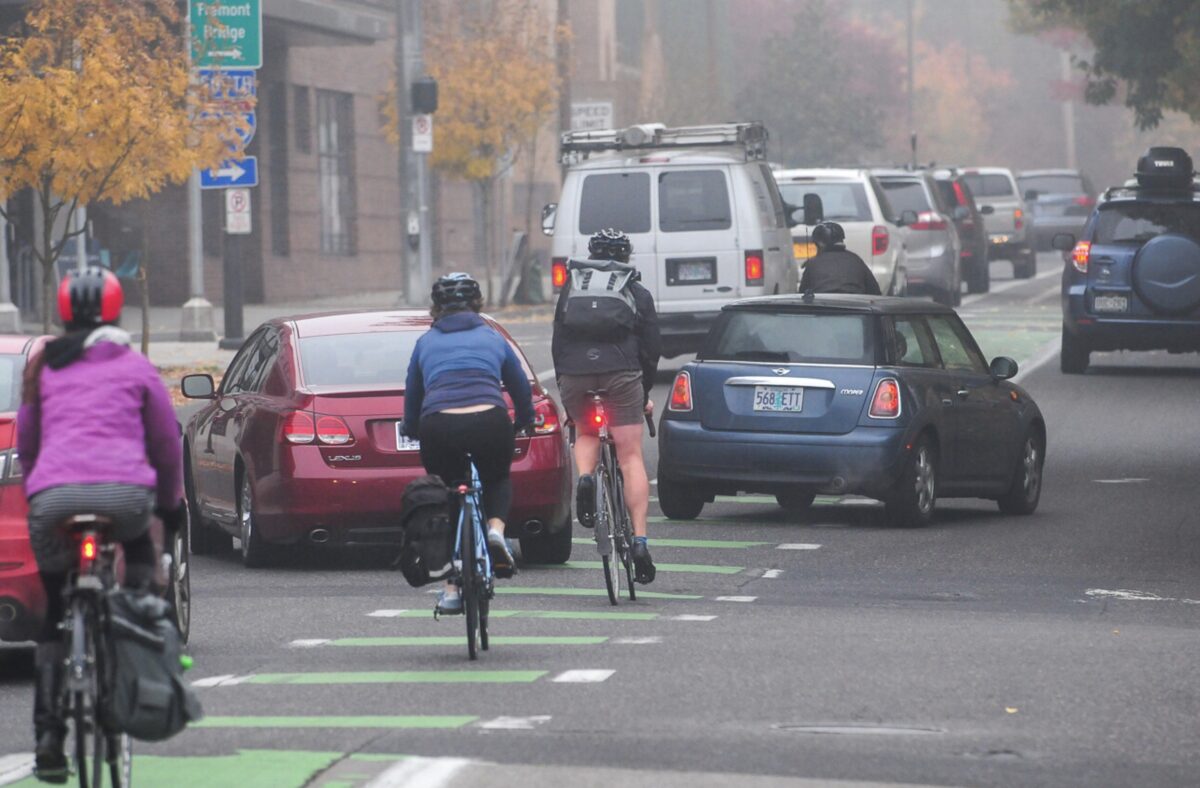
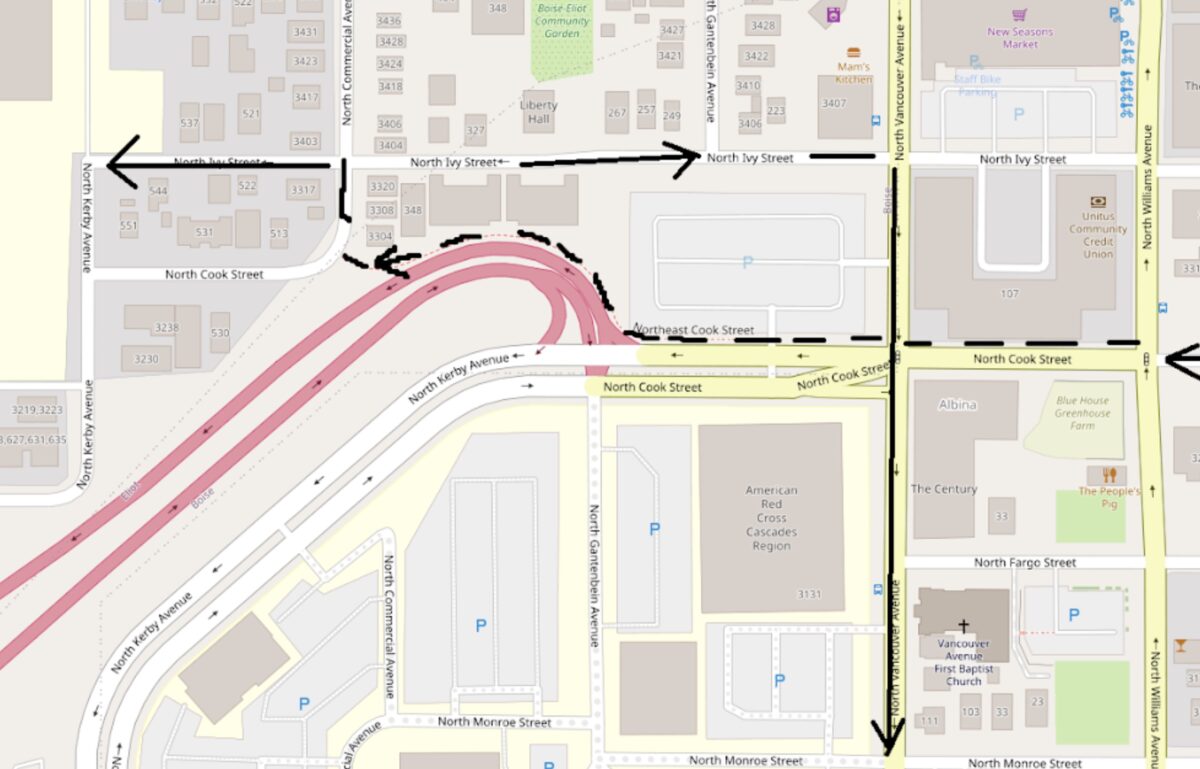
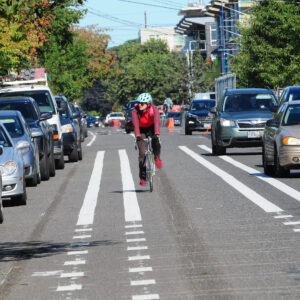
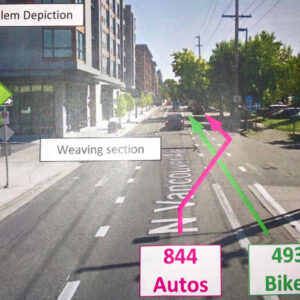
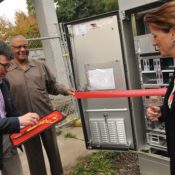
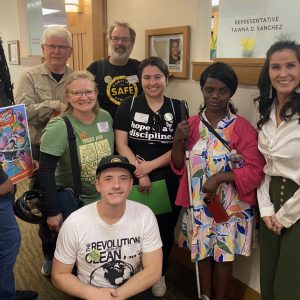
Thanks for reading.
BikePortland has served this community with independent community journalism since 2005. We rely on subscriptions from readers like you to survive. Your financial support is vital in keeping this valuable resource alive and well.
Please subscribe today to strengthen and expand our work.
Since you’re mainly traveling East-West in this area, this is a little tangential, but my observation is that drivers innately know the dangers of the door zone. Every time I’m either riding or driving southbound on Vancouver from north of Fremont, I observe nearly every other driver driving well away from the parked cars on their left with their wheels either on the buffer line (wearing it off) or fully in the buffer zone meant to protect cyclists with distance.
And, yes, that area between N Fremont and N Cook is an absolute mess of drivers driving in the green lane for most of the block getting to the right turn to get on the freeway.
Thank you Allan. It really is an indictment of one of our highest capacity bike thoroughfares that we do not feel comfortable riding on it with kids. I have personally been hit about a block from there (on Williams), nearly left hooked on another occasion, and have several clients who have been hit and injured on this stretch. Rodney is OK as a parallel alternative, but as usual with greenways is slow going and out of the way.
In a city full of very dangerous high crash corridors, mostly multi-lane arterials, many of them state highways run by ODOT, it’s a bit hard for me to get worked up about a street like Vancouver that might feel uncomfortable sometimes but is very unlikely to result in any serious injury or death. If everything is a priority, nothing is a priority. I think we should focus energy on the most dangerous streets. Even if you’re focused in that neighborhood, MLK has way more safety issues than Vancouver. Vancouver is definitely not perfect, and small tweaks would be great, but if we’re talking big money there are bigger priorities out there.
“…Vancouver that might feel uncomfortable sometimes but is very unlikely to result in any serious injury or death”
According to the injury and death data, Vancouver (and Williams) are pretty dangerous–with many injuries, including serious ones and death–even when judged against MLK.
https://pdx.maps.arcgis.com/apps/MapSeries/index.html?appid=5385b143768c445db915a9c7fad32ebe
Also, Vancouver serves a large population hemmed in to the west by I-5 and MLK to the east. (You’re right, MLK has safety issues for both traveling along and crossing.) That makes it more important that it and Williams function safely for walking and biking.
I agree there are more dangerous streets needing more attention, but on the other hand I’d place Vancouver and Williams up pretty high on any priority list. They are far from safe, they serve lots of people, and spending a given amount of money on them may get more results for more people faster than may be true of other many other streets.
When you have a nice road for biking and all of a sudden it becomes dangerous, that’s a big problem.
I do agree though that instead of focusing on slowing down greenways both ODOT and PBOT need to focus on slowing down all the car-heavy fast roads (stroads) in the city. PBOT always blames ODOT for roads like Powell but there are quite a few of those that PBOT takes care of that haven’t slowed down and are a hazard to pedestrians, cyclists and cars.
Duh, at this point everything is designed for motor vehicles. The motor vehicle operators need extensive reeducation, and infrastructure alone will never achieve that goal.
I’ve personally witnessed 3 car/bike crashes in my commutes up/down Williams and Vancouver. Each time, a car drove into a bicycle. Twice at the New Seasons exit from their parking lot onto N Williams and once at N Beech and Vanvouver Ave. Each time, the driver failed to yield and/or enter the lane safely striking a cyclist with their automobiles.
As someone who has been commuting 90+ miles per week in PDX since the 90’s, I do not allow my 12 and 15 year olds to ride on these busy and dangerous roads. Instead, we drive our daughter the 2 miles to school at Tubman Middle because it’s not safe for her to ride.
If ODOT and PDOT want kids to use bicycles to travel to school, they would prioritize roads that make it safe to do so. Until then, we’ll have to drive and be yet another motor vehicle on an already over-stuffed section of Platinum Bike Lanes taken over by cars. I’m curious how many kids bike to Tubman vs other middle schools and what that information tells us about a middle-school that is basically inaccessible to kids on bikes. Perhaps widening the freeway will help? I think not.
Amen, Johnny. N Williams is the one place in Portland where I came within a cat’s whisker of being hooked (left-hooked, in this case). Only a truck driver laying on his horn came between me and certain death. Also I know someone (personally) who was almost killed on this stretch by an impatient driver who cut across the bike lane – spent weeks in the hospital and months recovering.
This post makes a great case that this couplet feels unsafe but I’ll bet JM has a great summary of car-related injuries on this stretch and if not, I hope he will write one.
Do you all have capacity to do something like a bike bus once a week or even once a month to start? It’s a lot safer for kids in a group. I know middle schoolers aren’t a huge fan of doing anything with their parents, but getting kids riding together would be fantastic.
Thanks Allan for your column and your advocacy!
The root of the problem here and at numerous other locations around town is the freeway on and off ramps. Freeways would work better with fewer of them, but the goal for us in the rapidly warming 21st century is the total removal of all Portland freeways, and hence their ramps. We can use all that land for more housing, parks and other urban needs.
Frankfurt am Main for centuries had a hefty city wall, needed for protection from invaders of various sorts, but by the early 19th century Napoleon’s use of artillery made it obsolete. The walls were torn down and became a linear park, Die Anlage, that encloses the entire central city. Time to tear out our obsolete freeways. Let’s start with the Eastbank monster and its Marquam Bridge.